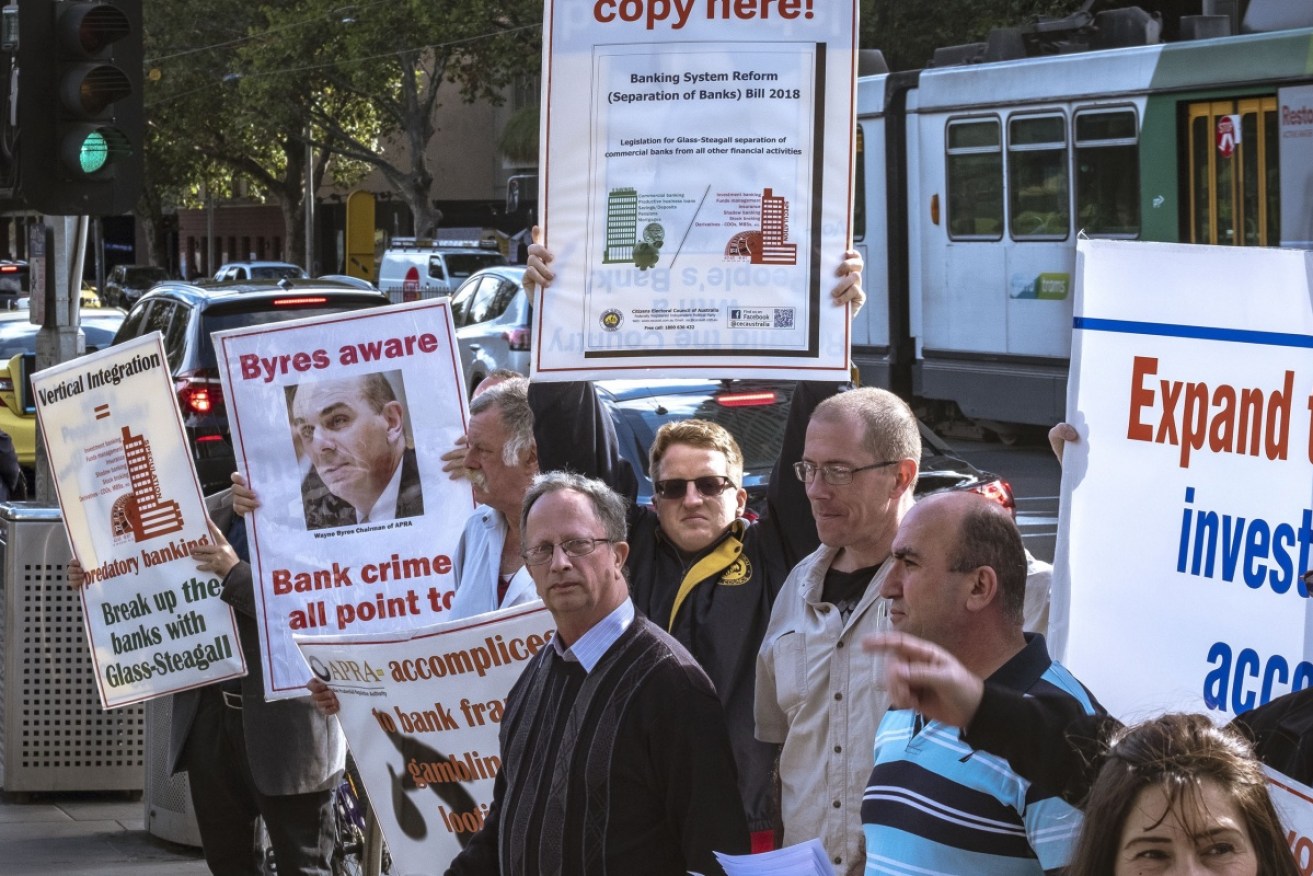Banks played a rigged game, but cheated anyway


Angry protesters gather outside the bank royal commission in Melbourne. Photo: AAP
The really staggering thing about the corruption and lies being exposed by the banking royal commission is how unnecessary it all was, given the privileged, government-backed nature of banks in the first place.
The big four banks have had a whale of a time in the past two decades, creating mountains of private debt in the mortgage market, extracting ridiculous fees for mismanaging customers’ savings and … what was the other thing?
Oh, yes, lending money to businesses that produce silly trifles such as housing, food, transport, medical services, education, entertainment and so on.
Businesses in those other sectors have to live by the law of the jungle. They raise capital, risk that capital on wages, buildings, plant and equipment, intellectual property and so on, and try to sell their goods and services at prices high enough to make a profit.
But the big banks are different – and for many reasons, not just a few.
- In times of crisis, such as the global financial crisis, they are ‘too big to fail’ and so enjoy an implicit guarantee that the government will bail them out.
- That guarantee has made banks less risky in the eyes of international investors, meaning they can raise money to fund their lending activities more cheaply than small banks – something for which they have only recently been forced to pay through the government’s ‘bank levy’.
- Australia’s dividend imputation system allows banks to return to their shareholders, via franking credits, the 30 cents of company tax they pay on each dollar of profit. That means that when a dividend is paid to non-taxpaying retirees, the ATO refunds the whole amount and nobody pays any tax on that dollar of profit. While that’s available to all companies, it’s the banks that consistently make huge profits, and whose shareholders benefit most from that taxpayer-funded largesse.
- Banks’ mortgage books have been swollen by a credit boom that began two decades ago when a 50 per cent capital gains tax discount was added to existing negative gearing rules to create a perverse incentive for housing investors to borrow ever-larger amounts of money.
- Loose lending requirements were tightened too little, too late, by the Australian Prudential Regulatory Authority, beginning at the end of 2014.
- Banks have been supported by politicians, business leaders and financial commentators who tell us that ‘when bank profits rise, everyone benefits because we all hold bank shares in our super’. That’s utter rubbish, because younger, poorer Australians own very few shares, but shoulder the massive debts that are the source of those “rising profits”.
In short, the big four banks have functioned as enormous government-sponsored enterprises (GSEs). Without the assistance of the government and the taxpayer their stellar shareholder returns could not be so high, or so consistent (see table below).
Those returns, extracted from young, heavily indebted, taxpaying households, flow to shareholders who mostly don’t know, or don’t want to know, where all that miraculous money comes from.
Investment web site The Motley Fool described the miracle in reference to the Commonwealth Bank last year: “Commonwealth Bank has a history of paying great dividends and increasing profits year after year … In fact, if we go back to a time in the early 1990s Commonwealth Bank shares were trading around $6 and paying a 40 cents per share dividend — equivalent to 6.6 per cent …
“Imagine if you still held shares from 20 years ago. In addition to all those dividends you would have received, and the capital gains you would today be nursing — your $4.20 forecast 2017 dividend would be equivalent to a yield of 70 per cent fully franked. That’s long-term investing.”
Wow! And the credit bubble CBA helped pump up along the way is long-term nation-wrecking.
There is nothing wrong with shrewd investors risking their capital on enterprises that, if they create enough value of their customers, end up paying 70 per cent yields.
But they have to create real value … not just a government-sponsored transfer of wealth between generations, a debt bubble, and now we discover a web of lies and lost billions through their wealth ‘management’ arms.
If they’d been more honest, these quasi private sector behemoths could have generated fat executive bonuses, above-market rates of return for shareholders, and nice dollops of donations for the politicians who kept telling us their huge profits were justified.
But instead of just continuing to play a game that was massively rigged in their favour, they felt the need to cheat as well.








